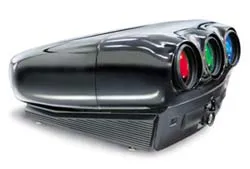Cathode Ray Tube - CRT Projection

Many of us can recall CRT projectors at special events or sports bars. Once the dominant force in professional projection CRT projectors have lost ground
because of their high running cost. Using three tubes or guns one for each primary colour the image is combine at the screen. This means that the image
must be calibrated by a trained professional on a regular basis. Add to this the initial cost, size and weight of the machines and you can see why they have
limited appeal.
On the plus side CRT projectors do not have a fixed number of pixels effectively giving them a 100% fill factor. This allows exceptional flexibility for
different input signals and a film like quality. In a dark room (lumen output is low) they are hard to beat.
A CRT is basically a large vacuum tube in which an electron beam, emanating from a single point in the neck of the tube, scans the face of the tube very rapidly,
which, in turn lights up phosphors on the tube's surface in order to create an image. A CRT produced image is not limited to a fixed pixel field, as are other
rear projection types. This makes video projection possibly the best option where the flexibility of displaying variable resolutions is the main consideration.
































